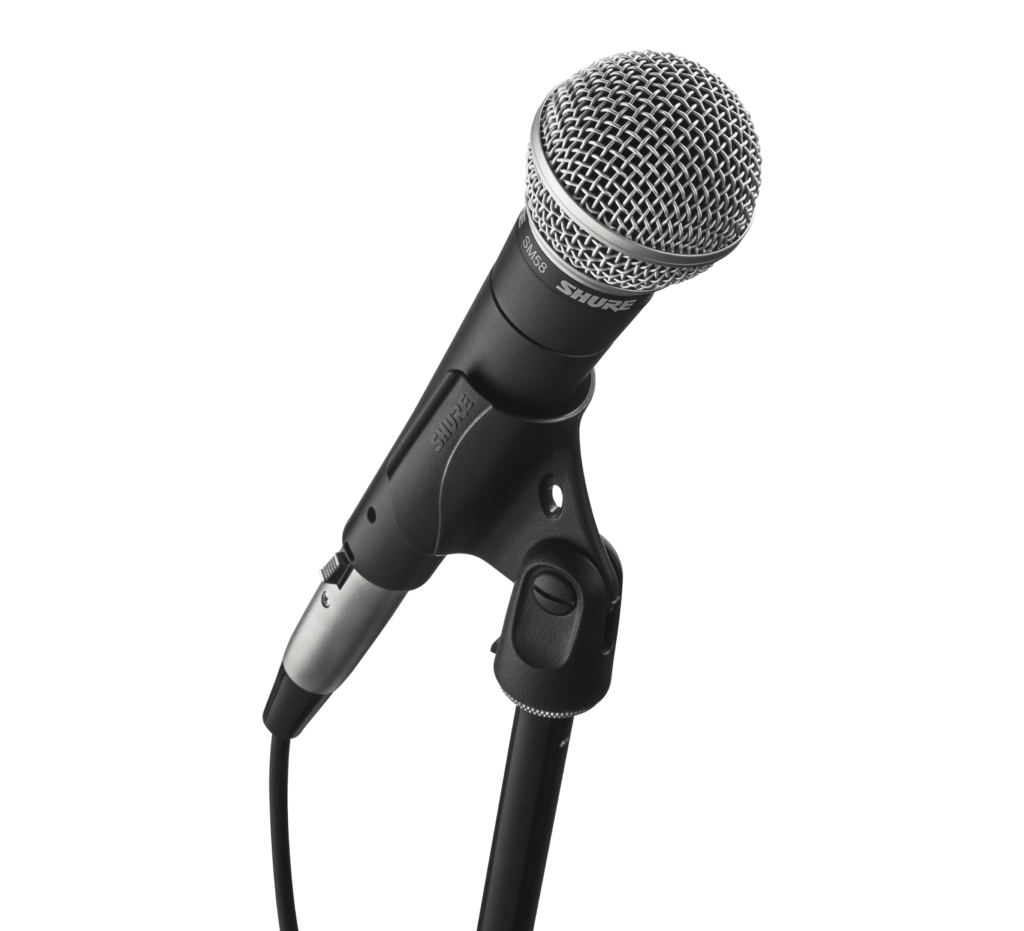
This year Shure celebrates its 50th anniversary of the world’s most popular mic, the Shure SM58 Vocal Microphone. Loyal users know that this rugged and reliable microphone sounds great. But many may not know some of the history and technical facts about it.
#1 The SM58 was almost scrapped in 1970.
A single competitor was so entrenched in the broadcast market that radio and television stations weren’t excited about the new Shure SM microphones. Sales were sluggish, and plans were afoot to discontinue the SM58 and the SM57. As a last-ditch effort, the Shure national sales manager suggested introducing the mics to live sound engineers in Las Vegas. The mics were a hit in Vegas, and entertainers began to embrace these models for live performances. As they say, the rest is history.
#2 Turn it up to 11.
How much SPL can the SM58 handle? At what point will the sound distort? The answer is much higher than would be safe for your ears: somewhere in the 150 to 180 dB SPL level, close to the noise level of a space shuttle launch. A well-designed dynamic like the SM58 is unlikely to reach its distortion point under normal circumstances.
#3 Ernie Seeler, the man behind the SM58, didn’t like rock and roll.
It’s ironic that a quiet man who preferred classical music invented a mic that would become synonymous with rock and roll, first capturing the attention of acts like The Who and The Rolling Stones. Shocked by its widespread adoption on the rock stage, Ernie Seeler said, “I love classical music, but rock and roll, I don’t take very seriously.”
#4 The SM58 capsule is still number one in Shure wireless.
Currently, there are fourteen microphone capsules available for Shure wireless microphone systems. They range from the affordable PGA58 dynamic element to the new KSM8 Dualdyne. Due to popular demand, the SM58 capsule is available for every one of the eleven Shure wireless lines.
#5 A huge mix of artists has turned this mic into the icon it is today.
The SM58 has been the microphone of choice for Roger Daltrey, Paul McCartney, Henry Rollins, Patti Smith, Alice Cooper, Buddy Guy, Cheap Trick, G. Love, Martina McBride, Megadeth and countless other musicians. In fact, it would be difficult to name a major entertainer who has not used the SM58 at some time in their career.
#6 The “SM” in SM58 stands for “Studio Microphone”.
Shure microphones had been a fixture in the public address market for nearly three decades when Shure executives saw growth potential in the radio and television broadcast markets of the early 1960s. This led to the development of the SM microphone series. The SM57 (1965) and SM58 (1966) were based on the popular Unidyne III 545 (1959) used for public address systems. These new SM models were intended for broadcast studio use, eliminating the on-off switch and featuring a non-reflective, dark grey finish.
#7 Add a meshed ball grille head to the SM57, and you have yourself an SM58.
Both models are based on the Unidyne III cartridge design developed by Shure engineer Ernie Seeler in the late 1950s. The primary difference between the SM57 and the SM58 is the grille design. The engineers designed the SM58 for vocal applications, and they utilized a ball grille that effectively acts as a P-pop filter. They designed the SM57 primarily as an instrument microphone, where a smaller grille size is preferred. In this application, P-pop is not a concern.
#8 Zero gravity? Not a problem.
Six astronauts on the International Space Station shared a wired SM58 that was floating around in a video interview with The New York Times in April 2011. It sounded great, and it provided a testing opportunity even Shure engineers could not have performed on Earth. The SM58’s performance characteristics when weightless.
#9 The SM58 is practically indestructible!
Shure has subjected the SM58 to caught-on-video tortures in a series of Shure Mike videos. Shure dropped the sturdy SM58 from a helicopter, dunked it in a pint of Guinness, shot it with a 12-gauge shotgun, ran it over with a tour bus, tossed it into the Pacific, grilled it alongside some hot dogs, and slap-shot it into the boards with the Chicago Wolves. Ernie Seeler tested the Unidyne III cartridge back in the 1960s by dropping, cooking, freezing, and submerging it. We can all thank the Shure Quality Assurance standards for its unfailing durability 50 years later.
#10 The acoustic design of the 58 can be traced back to the 1939 Unidyne Model 55.
All Shure unidirectional cardioid microphones employ the revolutionary Uniphase acoustical network that engineer Ben Bauer began developing in 1937 and used in the Unidyne Model 55 microphone (1939). Ernie Seeler advanced this technology in the 1950s by designing an end-address microphone with an internal pneumatic shock mount, the Unidyne III. The SM58 has a Unidyne III cartridge.